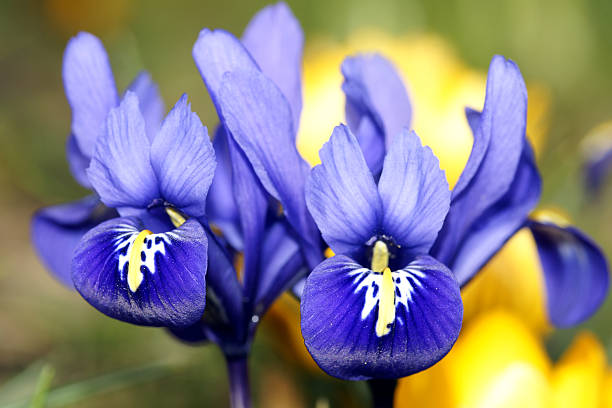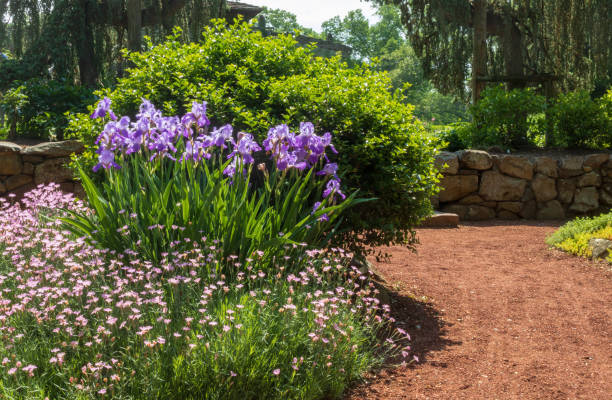Does Iris Need Fertilizer?
Fertilizer Iris if it shows that it needs. Do a soil test first to find out. You can look for signs by how your Iris looks if it gets enough nutrients it needs. Iris may not need fertilizer, but that doesn’t mean you can skip it! Fertilizer is an essential part of a healthy garden, and it is especially important for irises. Fertilizer helps to feed the plant nutrients and encourages growth. When applied correctly, fertilizers are safe to use and do not contain harmful chemicals.
Iris may not need fertilizer during the early stages of growth, but it will require more nutrients as the plant matures. A typical fertilizer application for irises should be every three to four weeks during the growing season, starting in early spring and continuing into late summer. Make sure to read the fertilizer label you choose to make sure that it is suitable for irises. Some fertilizers designed explicitly for irises include 20-20-20, 22-12-10, 13-13-13, and 10-10-10.

Table of Contents
Signs that Your Iris Needs Nutrients
No Blooms
You may need to divide your Irises if they refuse to bloom or don’t bloom as much as you’d expect. If you have a lot of Irises, you may find that they don’t bloom often enough. When this happens, it’s easy to divide Irises and get them to bloom.
Yellow Leaves
If you notice yellowing leaves on your plants, they may be suffering from a deficiency of nitrogen or potassium. A spot with good drainage, plenty of organic matter, and deep enough planting are all requirements for successful iris cultivation. There is a correlation between yellow leaves and heavy or sandy soil. Adding a 10-10-10 fertilizer and organic material to your soil will help your plants grow and bloom more vibrantly. Iris Leaf Spot, a fungus, can also cause yellow leaves.
The Absence of Plant Growth
If you notice a lack of green growth or stubby leaves, you may have a nitrogen deficiency or poor growing conditions. Remember to plant in well-draining soil that gets plenty of sunlight. Stunted Irises can be caused by a lack of sunlight.
Discoloration
Phosphorous deficiency can cause Iris leaves to turn red or purple. Using 10-10-10 or sprinkling bone meal around the base of the Iris is all that is needed to fix this.
Leaf Patterns with Spots, Stripes, or Squishy Roots
An Iris plant with striped or spotty leaves may be infested with iris borers, most common in the eastern United States. When dealing with the Iris borer, you may want to switch to more Siberian Iris in the future if you’ve had problems with the pest.
The Iris borer can be detected by removing an entire clump of iris bulbs, dividing them with a sharp knife, and inspecting their root systems. Squishy rhizomes are a good indicator of the presence of a pest. Treatment with an insecticide (spinosad or acephate) at the exact moment the borer eggs hatch reduces the infestation effectively.

When to Fertilize?
- An Iris clump should be lightly fertilized a month before blooming in the spring. For dwarf iris, which blooms in March, the same holds true. In the middle to late February, use a low-Nitrogen fertilizer on your dwarf iris. During the month leading up to the bloom cycle of your intermediate and tall bearded Iris, do the same.
- Add a tablespoon of fertilizer to the newly planted rhizome before planting. A low-nitrogen fertilizer, such as 6-10-10 (or 1 12 oz per 10 ft2), can be added to your garden bed if you plan to grow irises in a large area.
- After your irises have finished blooming, you should feed them again. Doing so ensures that they are in peak condition for the upcoming growing season. Wait a few months after the flowers have faded, or in the fall, the Iris have enough time before winter to get the nutrition they need.
Which Fertilizer to Use?
Bone meal and a standard 10-10-10 fertilizer are the most common irises fertilizer options. If your soil is acidic, you may be able to raise its pH by adding calcium (between 4-6 pH). The soil will become more alkaline due to the calcium addition (between 8-9 pH). An animal’s bones are used to make bone meal fertilizer, which is exactly what it sounds like.
If you’re a novice gardener or have never taken an FFA class, you might not know what N-P-K stands for. Nitrogen is denoted by the letter N, phosphorus by the letter P, and potassium by the letter K. An all-purpose 10-10-10 fertilizer can be used on healthy plants because it contains equal parts Nitrogen (10 N), Phosphorus (10 P), and Potassium (10 K).
Iris fertilizers typically have a nitrogen content of 4-10-10 or 6-10-10, indicating that they are meant for plants with lower nitrogen requirements than other leafy plants.
The phosphorus in bone meal is great for the new iris rhizomes your bulbs are creating, so it’s commonly used beneath the iris clump when planting (generally in late spring). To maximize the amount of water and nutrients that can be absorbed by your iris plant, you should plant rhizomes in the soil. Apply 1 tablespoon of fertilizer per clump of bulbs below the soil surface to encourage new growth.
An organic fertilizer that has been well-composted can also contain a wide range of micronutrients.
How to Fertilize Iris
- If you have already made a new planting bed with compost and fertilizer, you don’t need to add any more fertilizer when you plant irises. Soil tests show that the flowers will be better if you add bone meal to each hole where a plant is going in. It is best to apply up to 1 pound of fertilizer per 100 square feet before you plant irises in a flower bed that has been there for a long time.
- Always follow the application instructions on the packaging. It’s important to remember a few things when fertilizing your plants.
- When fertilizing an established plant, apply a few inches around the plant rather than directly onto the plant’s surface. Fertilizers meant for soil use can burn plants if applied directly to the plant, which is a common blunder in newer formulations.
- Don’t apply fertilizer to your plants during the hottest part of the day or late evening. Preventing fungal disease is easier if you apply topical fertilizers in the early morning, when leaves are still wet, rather than when they are hot and dry.
- A light fertilizer application after bloom or in the late summer will help ensure healthy growth for the rest of the year.
Benefits of Feeding Your Iris
Fertilizing irises can be beneficial for various reasons, including reducing the amount of weed needed, improving flower production, and increasing crop yields. By fertilizing your Iris, you provide your plants with the essential nutrients they need to grow and flower.
One of the most essential nutrients for plants is nitrogen, and fertilizing with nitrogen helps increase the plant’s ability to absorb other nutrients. Additionally, fertilizing with nitrogen will help to improve flower production and prolong the life of the flowers. Fertilizing with nitrogen also helps to increase crop yields by providing the plants with the necessary nutrients to grow.
There are a few ways to fertilize your iris. You can either use a soil drench or a foliar spray. The soil drench is the best option for people with limited time, as it is quick and easy to do. The foliar spray is more effective, but it is also more expensive.
